Sourcing from Alibaba to sell on Amazon FBA is a well-known e-commerce strategy for good reason. The model is straightforward: you find and buy low-cost products directly from manufacturers on Alibaba, then you use Amazon’s fulfillment network to sell them to a massive audience. This is the exact approach that has launched countless private label brands, creating a direct pipeline between Alibaba’s manufacturing world and Amazon’s retail empire.
Why This Model Is a Go-To for Private Label Sellers
The Alibaba to Amazon FBA strategy has become the default for so many sellers because it pairs a global factory with a world-class sales and logistics machine. Think of it as a powerful partnership. Alibaba opens the doors to factories that can produce almost anything you can imagine, usually at a fraction of what it would cost to source domestically.
Then, Amazon FBA steps in to do the heavy lifting.
- Inventory Storage: Forget renting a warehouse. Amazon stores your products in their fulfillment centers.
- Order Fulfillment: When an order comes in, Amazon’s team picks, packs, and ships it for you.
- Customer Service: They handle returns and customer questions, which saves an incredible amount of time.
- Prime Shipping: Your products are instantly eligible for Prime’s free two-day shipping, which is a massive reason why customers click “buy.”
This setup lets you focus on what really matters—finding a winning product and marketing it—while two of the world’s biggest platforms handle production and fulfillment.
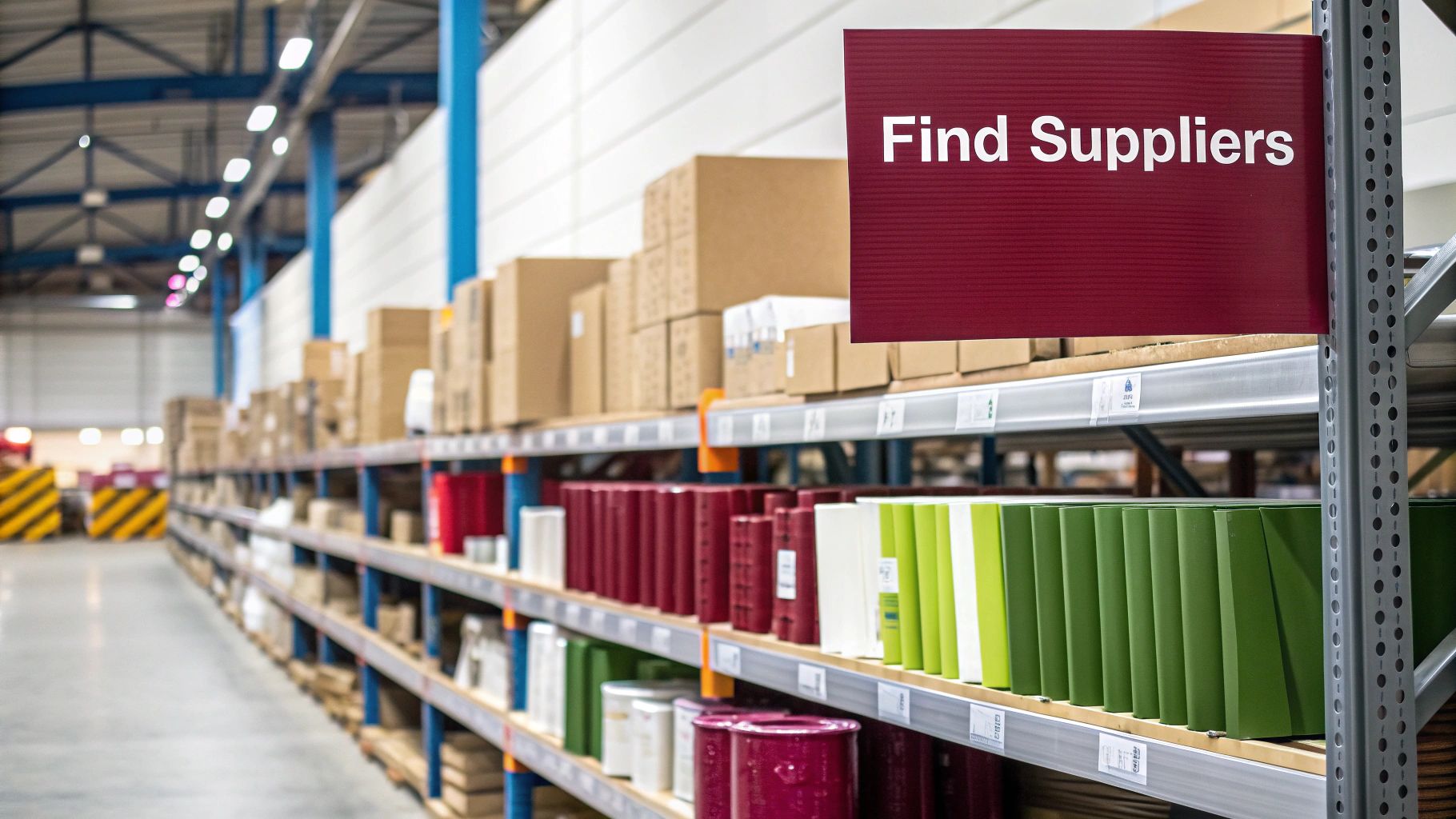
The Alibaba homepage is your starting point, acting as a search engine to connect with manufacturers and wholesalers from all over the world.
To help clarify the roles these two platforms play, let’s break down their core functions from a seller’s point of view.
Alibaba vs. Amazon FBA at a Glance for Sellers
| Characteristic | Alibaba | Amazon FBA |
|---|---|---|
| Primary Function | B2B Manufacturing Marketplace | B2C Retail & Logistics Network |
| You Use It For… | Sourcing, negotiation, production | Selling, storage, shipping, customer service |
| Typical Order Size | Bulk (hundreds or thousands of units) | Individual customer orders |
| Your Role | The buyer/importer | The seller/brand owner |
| Key Advantage | Low production costs, customization | Access to Prime customers, hands-off fulfillment |
This table shows how Alibaba and Amazon FBA aren’t competitors in this model; they’re two sides of the same coin, each handling a distinct part of the supply chain.
The B2B to B2C Hand-Off
Amazon is a Business-to-Consumer (B2C) titan, built from the ground up to sell single items directly to shoppers. Everything about it, from the product pages to the FBA system, is optimized for retail.
Alibaba, on the other hand, is a Business-to-Business (B2B) marketplace. It was designed to connect factories with businesses that need to order products by the pallet, not by the piece. This fundamental difference is precisely what makes them perfect partners for you. You use one platform to make the product and the other to sell it.
The power of the Alibaba to Amazon FBA model is all about using two highly specialized platforms to build a scalable e-commerce business without ever needing to see, touch, or ship the inventory yourself.
The Perfect Path for Private Label Brands
If your goal is to build your own brand, this is the way to do it. You’re working directly with a manufacturer to put your logo on a product, design custom packaging, and even make improvements to the item itself. This is how thousands of successful private label brands get their start. Our complete guide on how to start an ecommerce business on Amazon walks you through those first crucial steps of building a brand from nothing.
This guide will take you through the entire journey, from finding a supplier you can trust on Alibaba all the way to getting your inventory checked into Amazon’s warehouses, ready for that very first sale.
Finding a Reliable Alibaba Supplier You Can Trust
Alibaba is a massive platform, so the first job is to cut through the noise. Not every listing is a top-tier factory ready to handle your business. You have to use Alibaba’s own tools to your advantage.
Start with Smart Filters
Before you even start scrolling, you need to apply two non-negotiable filters: Verified Supplier and Trade Assurance. Seriously, don’t even look at anyone who doesn’t have both.
- Verified Supplier: This badge is a big deal. It means a real, third-party inspection company has physically walked through the factory. They’ve audited their production lines and confirmed they’re a legitimate operation. It’s a huge step up from the old “Gold Supplier” status, which was much easier to get.
- Trade Assurance: Think of this as Alibaba’s built-in escrow service. Your payment is held securely until you confirm the goods have been shipped and meet the quality standards you agreed on. If a supplier doesn’t offer this, it’s a massive red flag. Walk away.
Just by clicking these two boxes, you instantly filter out a huge chunk of low-quality or downright risky suppliers. It saves a ton of time and prevents a world of future headaches.
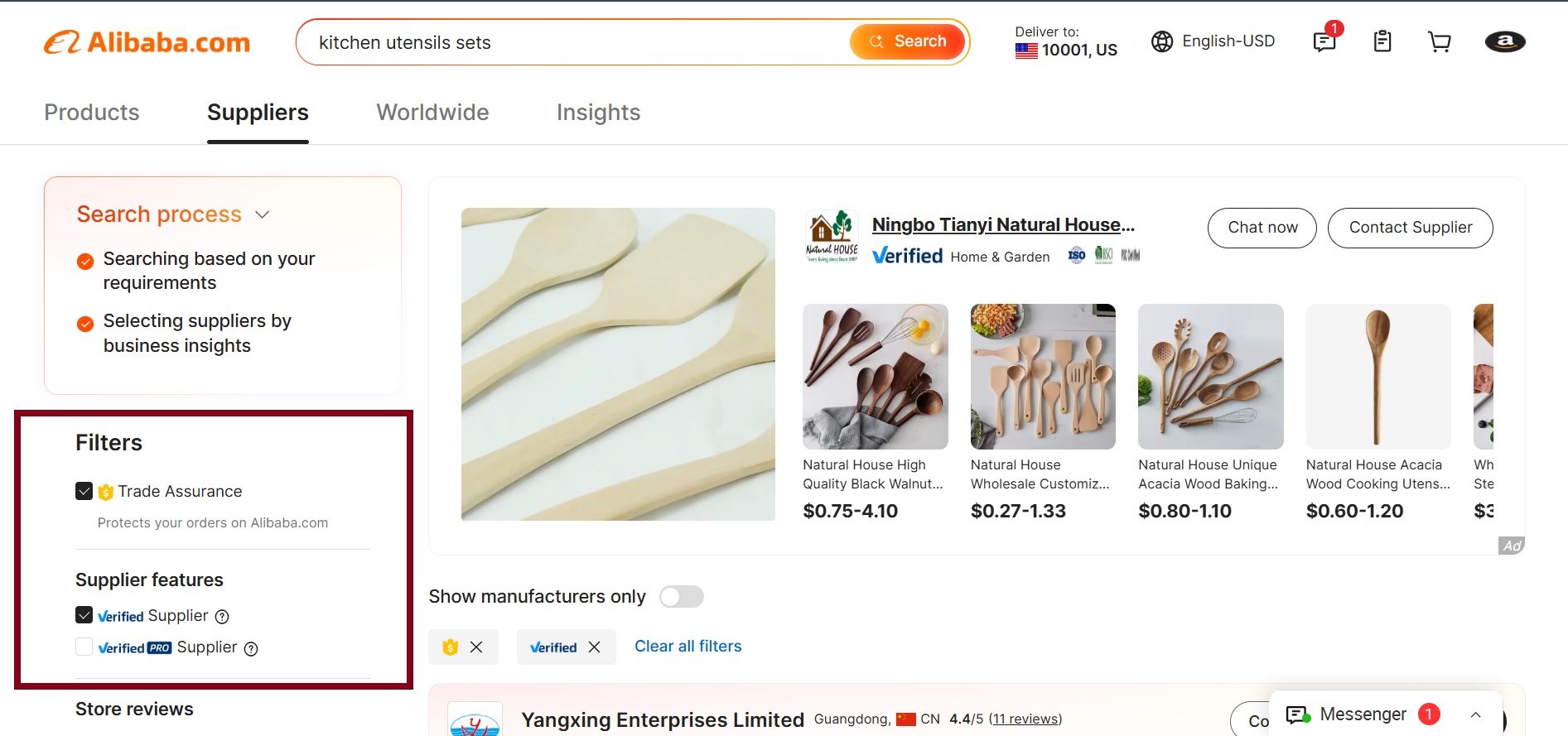
How to Vet a Supplier’s Profile
Once your search results are narrowed down, it’s time to do some digging. Treat each supplier profile like you’re reviewing a resume. You’re looking for signs of experience, professionalism, and a track record of reliability.
Here’s a quick checklist of what I look for on their company page:
- Years in Business: I always look for suppliers with at least 3 to 5 years of experience. A newer factory might offer a cheaper price, but they’re far more likely to mess up production or botch the shipping process, especially for an Alibaba to Amazon FBA shipment.
- Main Products & Markets: Do they actually specialize in your product category? A factory that only makes silicone kitchen gadgets is a much safer bet for your new spatula than a generalist factory pumping out everything from phone cases to t-shirts. Also, check their main export markets. If they’re already shipping to the U.S. or Europe, they’ll be familiar with international quality standards.
- Response Rate: Look for a response rate over 90%. It’s a simple metric that shows they’re attentive and professional. If they take three days to answer your first message, just imagine the radio silence when you have an urgent production issue.
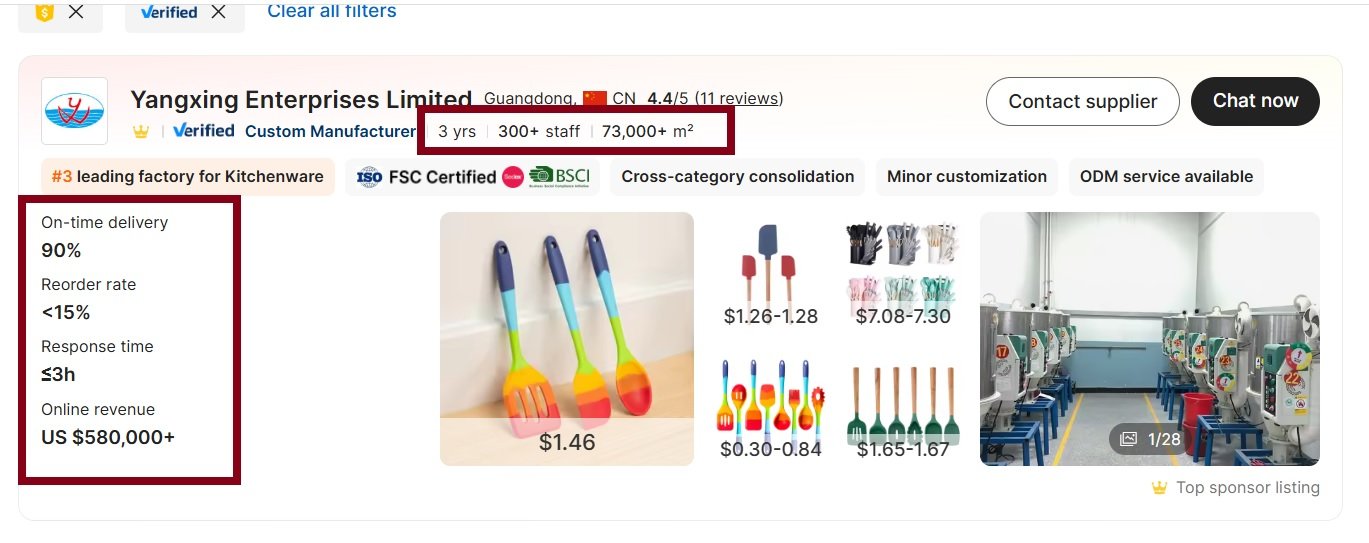
Pro Tip: A supplier’s profile can look perfect, but their communication tells the real story. How they answer your questions is just as important as the answers themselves. Are their responses clear and detailed? Or are you getting generic, copy-pasted replies that don’t actually address your questions?
Sending That First Message
Your first message is a test. You’re gauging their responsiveness, but you also need specific information. Ditch vague questions like, “How much for this?” You need to sound like a professional, serious buyer.
Here’s a simple template you can adapt:
Subject: Inquiry for [Product Name] for Amazon FBA
Body:
Hi [Supplier Name],
My name is [Your Name], and I’m the purchasing manager for [Your Company Name]. We are interested in your [Product Name] for the U.S. market to sell on Amazon FBA.
Could you please provide the following details:
- Your price per unit at an MOQ of 500 units?
- What is the production lead time for 500 units?
- Can you customize the product with our logo?
- What is the cost and lead time for a sample shipped to [Your City, ZIP Code]?
Thank you, I look forward to your reply.
[Your Name]
This message immediately shows you know what you’re doing and asks direct questions that test their transparency from the get-go.
The Most Important Step: Ordering Samples
Looking at pictures and reading profile descriptions gets you nowhere. You absolutely, positively must order samples before you even think about a bulk order. In fact, you should order samples from your top three to five suppliers.
This is the only way to physically hold the product, test its durability, and see the real-world differences between what each factory can produce. Yes, it costs a bit of money and takes time.
But this step can save you from losing thousands of dollars on a container full of junk. It’s the single best investment you’ll make in this whole process.
This is especially true if you’re building a brand from scratch. Product quality is everything. For more on this, check out our in-depth guide to starting a private label on Amazon FBA.
Your Next Step: Don’t rush finding a supplier. Use Alibaba’s filters, vet every profile carefully, test their communication with a professional outreach, and always order samples from multiple contenders. Finding the right partner is the foundation of a successful Alibaba to Amazon FBA business.
How to Negotiate and Place Your First Order
You’ve done the hard part of vetting suppliers and now have some quality samples sitting in front of you. This is the moment things get real. You’re about to shift from just another inquiry to a serious business partner, and how you handle this next phase is critical.
Good negotiation is all about building a partnership and finding terms that work for everyone, setting the stage for a long and profitable relationship.
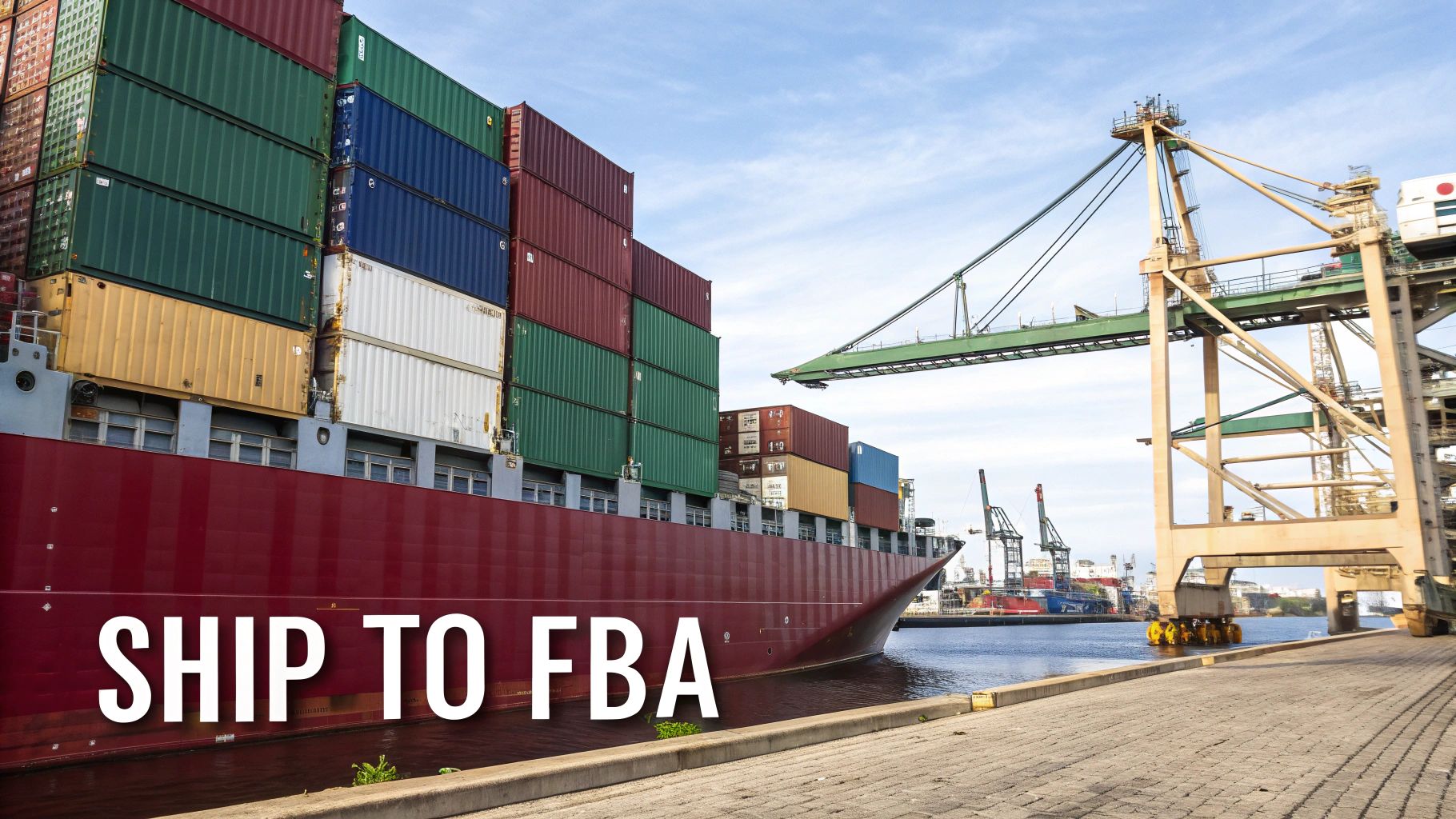
Evaluating Your Product Samples
Before you even start talking numbers, you need to be 100% confident in the product. When those samples land on your doorstep, don’t just give them a quick once-over. It’s time to put them through their paces.
- Functionality Test: Does it actually do what it’s supposed to do? Use it. A lot. If it’s a kitchen gadget, cook with it for a week. If it’s fitness gear, put it through a real workout.
- Durability Check: Try to find the weak spots. Are the seams solid? Does the plastic feel cheap or sturdy? Does it feel like it will hold up over time?
- Aesthetic Review: Scrutinize the colors, the finish, and the overall look and feel. Pull up the product photos and your spec sheet and compare them side-by-side.
Once you’ve done a thorough shakedown, compile your feedback for the supplier. Be specific. Use photos or even short videos to highlight any flaws or areas you want improved. This shows you’re a serious, detail-oriented buyer and helps them understand exactly what needs to be perfect for the bulk order.
Negotiating Price and MOQ
So many new sellers get hung up on the unit price, but it’s just one piece of the puzzle. The real goal is to strike a balance between price, quality, and a realistic Minimum Order Quantity (MOQ).
Remember, a supplier’s first quote is rarely their best offer.
Don’t be shy. A simple, “Is this your best price?” can go a long way. You can also try framing it around volume, like, “If we commit to 1,000 units instead of 500, could we get the price down to $X.XX?”
But be careful. Pushing too hard for a rock-bottom price can seriously backfire. A factory that agrees to an unsustainably low price will have to cut corners somewhere, whether it’s using cheaper materials or rushing through quality control. Aim for a fair price that lets them make a quality product and still turn a profit.
Payment Terms: The 30/70 Split
When it’s time to pay, the industry standard is the 30/70 payment structure. For your first few orders, this is non-negotiable. It’s your best tool for protecting your cash flow and ensuring you get what you ordered.
Here’s the breakdown:
- 30% Deposit: You’ll pay 30% of the total order value upfront. This is standard practice and allows the factory to purchase the raw materials and get production rolling.
- 70% Balance: The remaining 70% is paid only after production is finished and a third-party inspection confirms the goods are up to your standards.
Never, ever pay 100% upfront. The 30/70 split gives your supplier a powerful incentive to get things right the first time, because they don’t get the majority of their money until you’ve given the final approval.
Key Insight: This payment structure is your most powerful form of leverage. It keeps you in control and minimizes your financial risk, ensuring you don’t pay in full for an order that has quality issues.
As you get ready to send money overseas, it’s also a smart move to get a handle on how exchange rates work. Getting a better grasp of understanding the global currency exchange market can save you a surprising amount of money on your order.
Alibaba Payment Methods
Alibaba offers various payment options to ensure a secure and convenient experience for its users. Some of the common methods include credit and debit cards, bank transfers, and online payment systems.
Additionally, Alibaba’s Trade Assurance provides an extra layer of security by protecting buyers during transactions. This variety of payment solutions caters to both local and international users, facilitating seamless transactions across the platform.
Placing Your Order with Alibaba Trade Assurance
Once you’ve agreed on all the terms, it’s time to make it official. For your first order, and likely many more, the only way you should do this is through Alibaba Trade Assurance.
Trade Assurance works like a free escrow and contract service. It locks in every detail you and your supplier have agreed on, creating a formal record. This includes:
- Exact product specifications
- The final unit price and total order value
- Production lead time and the shipment date
- Quality standards and inspection details
When you pay through Trade Assurance, your money is held by Alibaba, not sent directly to the supplier. The funds are only released after you confirm the order has shipped and meets the quality you agreed upon. If something goes wrong, like a major quality failure or a missed shipping deadline, Trade Assurance gives you a clear process to file a dispute and potentially get your deposit back.
Wondering how all these costs add up? We put together a complete guide on how much it costs to sell on Amazon to help you plan your budget.
Your Next Step: Your first order sets the tone for your entire supplier relationship. Negotiate fairly, insist on the 30/70 payment split, and always use Alibaba Trade Assurance. These steps will protect your investment and build a solid foundation for your Alibaba to Amazon FBA business.
Managing Production and Product Inspections
Once you’ve sent the deposit, it’s tempting to lean back, put your feet up, and just wait for the factory to tell you your goods are ready. Big mistake. This period, between paying your deposit and your products hitting the water, is one of the most critical phases in the entire Alibaba-to-Amazon process. It’s not a waiting game; it’s an active management game.
You need to stay in regular, professional contact with your supplier. A simple check-in every week or so is plenty. Ask for updates on the production timeline, and when it makes sense, request a few photos from the production line. This keeps your order top-of-mind for them and helps you catch potential delays long before they turn into major headaches.
Why You Can’t Afford to Skip a Third-Party Inspection
Let me be clear: this is the single most important step to protect your investment. Do not rely on the factory’s internal quality control. Their job is to ship the product and get paid. Your job is to make sure that product is perfect. You absolutely must hire a third-party inspection service to be your eyes and ears on the factory floor.
Companies like QIMA, V-Trust, or AsiaInspection are the go-to choices here. For around $200 to $300, they’ll send a professional inspector to the factory to physically check your products before you wire over that final 70% balance. This is non-negotiable. Trying to save a few hundred bucks here can cost you thousands in unsellable inventory and put your Amazon account health at risk.
The best time to schedule this is when at least 80% of your production run is finished and fully packaged. This ensures the inspector can pull a large, random sample that gives you a truly realistic picture of the overall quality.
What Inspectors Actually Look For
An inspector does a lot more than just look for broken items. They follow a detailed checklist, which you help create, based on an industry standard called Acceptable Quality Limits (AQL). The report they send back is incredibly thorough and will cover things like:
- Workmanship and Visual Defects: They’re hunting for scratches, dents, incorrect colors, or just sloppy assembly.
- Quantity Verification: They count the cartons to make sure the factory actually produced the number of units you ordered.
- Product Specifications: They’ll break out calipers and scales to confirm that the dimensions, weight, and materials all match your spec sheet.
- Functionality Testing: They perform on-site tests to make sure the product actually works the way it’s supposed to.
- Packaging and Labeling: They verify that your shipping cartons are correct, your FNSKU labels are applied properly, and any required warning labels are present.
What to Do When an Inspection Fails
It’s actually pretty common for an inspection to flag some issues, especially on your first run with a new factory. Don’t panic. A failed report is your best friend; it’s leverage. You now have a professional, third-party document that outlines every single defect in detail.
Take that report back to your supplier and calmly walk them through the problems. A good supplier will own it and work with you to either rework the defective units or remake them entirely. This is exactly why you haven’t paid your final balance yet. Once the factory says they’ve fixed everything, you can have them send photo proof or, for more serious issues, pay for a quick re-inspection.
Getting this right is crucial for a smooth Amazon product launch, because it stops defective products from ever making it into a customer’s hands.
Your Next Step: Stay on top of your supplier during production. A third-party inspection isn’t optional; it’s your insurance policy. Use the inspection report as leverage to ensure you only accept and pay for products that meet your quality standards.
Handling Shipping, Customs, and FBA Prep
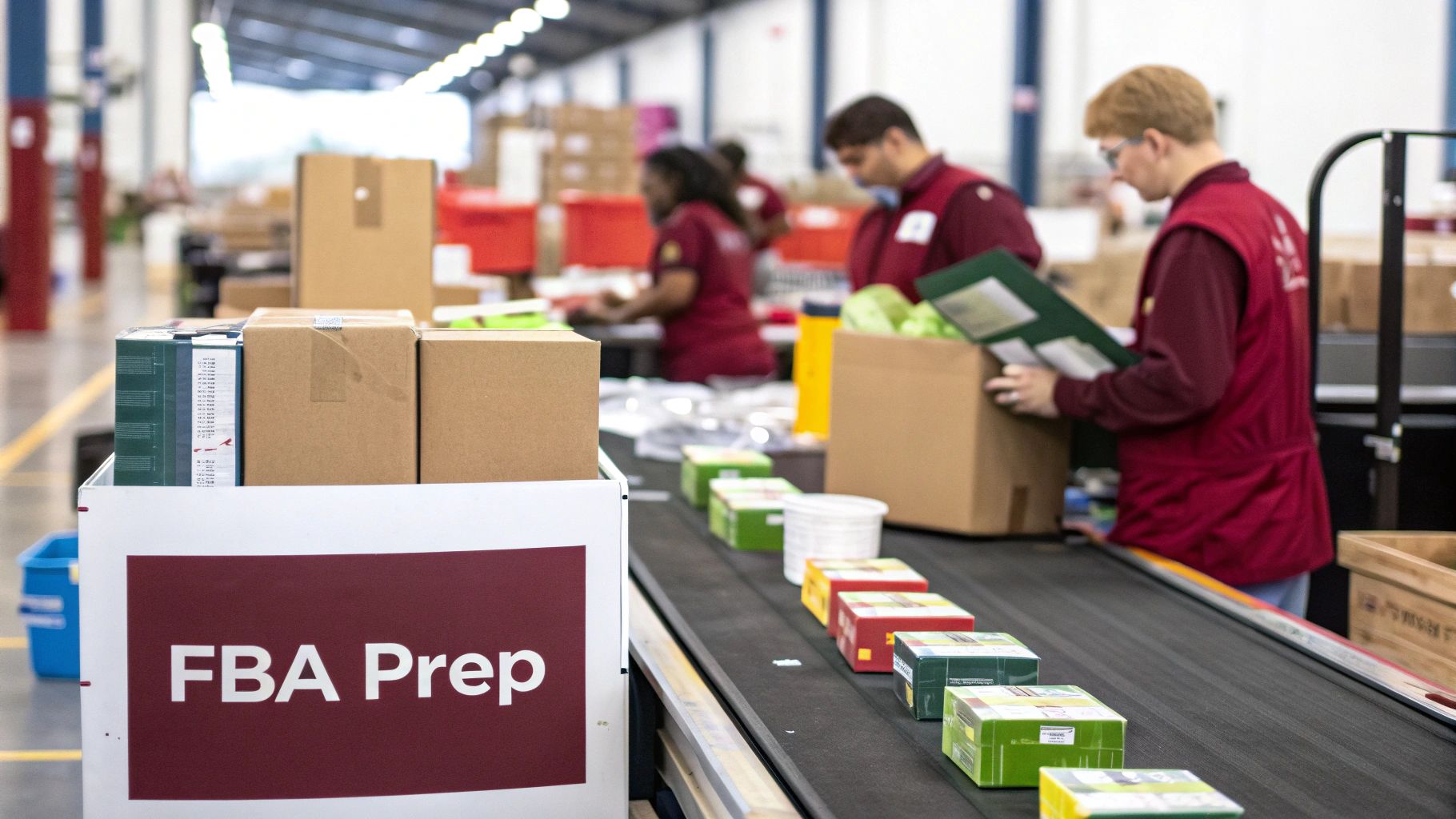
Alright, your products passed inspection, and you’ve sent the final payment to your supplier. Now for the part that trips up a lot of new sellers: getting your inventory from a factory in China all the way to an Amazon FBA warehouse.
This stage is all about logistics, and while it might sound intimidating, it’s a well-traveled path. The key is to understand your options and, more importantly, partner with the right people to handle the heavy lifting. You don’t need to become an international shipping expert overnight.
What you do need is a freight forwarder. Think of them as the travel agent for your products. A good one will coordinate everything from picking up the cartons at your supplier’s factory to clearing U.S. customs and arranging the final delivery to Amazon. They are your single point of contact for the entire process, saving you from a world of logistical headaches.
Choosing Your Shipping Method
Your freight forwarder will lay out a few ways to get your products across the ocean. The right choice really boils down to your budget, your timeline, and the size of your order.
- Sea Freight: This is the go-to for most Amazon sellers and the most cost-effective method for bulk shipments. The downside? It’s slow. You’re often looking at 30 to 45 days just for the ocean journey. But if you’ve planned your inventory well in advance, the cost savings are huge.
- Air Freight: A much faster option, usually taking around 7 to 10 days. It’s also significantly more expensive, which makes it a good choice for smaller, lighter products or when you’re in a pinch and need to restock before you run out.
- Air Express: This is the lightning-fast option, using carriers like DHL or FedEx. Your shipment can arrive in as little as 3 to 5 days, but the cost is extremely high. This is typically reserved for urgent situations, like sending product samples, or for a tiny restock to avoid going dark during a peak season.
For your first big order from Alibaba to Amazon FBA, sea freight is almost always the right move unless your product is tiny or you’re launching right before Q4.
The Role of a Freight Forwarder
A reliable freight forwarder does way more than just book space on a container ship. They manage a complex chain of events to get your inventory from your supplier’s gate to Amazon’s receiving dock.
Here’s a quick look at what they handle:
- Arranging the truck to pick up goods from your supplier.
- Booking the actual sea or air freight.
- Managing all the export paperwork out of China.
- Acting as your customs broker to clear your goods with U.S. Customs.
- Coordinating the final “last mile” delivery to the specific Amazon fulfillment center.
This is why finding a good one is so critical. They become a vital partner in your supply chain.
Amazon FBA Prep: The Non-Negotiables
While your goods are on the water, you need to get everything lined up on the Amazon side. This means creating a shipping plan in Seller Central and ensuring your products meet Amazon’s notoriously strict prep requirements. Mess this up, and your inventory could be rejected at the warehouse, leading to costly delays and a lot of frustration.
Your products have to be “e-commerce ready” before they ever arrive. This just means they need to be packaged to survive the rough-and-tumble warehouse environment. As you prepare your shipment for FBA, you might want to consider custom product packaging to not only protect your items but also give your brand a more professional look.
The single most critical prep task is labeling. Every single one of your units needs an FNSKU (Fulfillment Network Stock Keeping Unit) barcode. This is Amazon’s internal tracking code, and it’s how they know the products belong to you. You’ll generate these labels inside your shipping plan.
The suppliers know this, so you can print the FNSKUs and send them to the supplier to put on the products. If you’re making 1,000 units, print 1,000 FNSKUs.
Log in to your Amazon Seller Central account. Go to the Inventory section and select Manage Inventory. Choose the products you want to label and click on Print Item Labels. Customize the label settings as needed, then download the label file.
Amazon’s FBA network is massive, with over 100 fulfillment centers in the U.S. alone. This huge system, run by a mix of people and robots, is what makes Prime delivery possible, but it all hinges on your products being prepped and labeled perfectly.
A smooth shipment comes down to solid planning and working with experienced partners. And if you’re thinking bigger, it’s worth checking out our guide on selling globally on Amazon to get a handle on the different requirements for other marketplaces.
Product Launch Strategy
Sourcing and shipping your product from Alibaba is only the initial step. For a successful launch on Amazon, you need a comprehensive strategy. To achieve this, consider visiting our strategy on Amazon Product Launch, which offers detailed guidance for an effective launch.
Common Questions About Sourcing from Alibaba
Jumping into the Alibaba to Amazon FBA world always kicks up a lot of questions. That’s perfectly normal. Most new sellers get hung up on the same handful of worries before they even think about placing their first real order.
Let’s cut through the noise and tackle the most common ones head-on.
Can I Really Trust Alibaba Suppliers?
This is the big one, isn’t it? The short answer is yes, but you absolutely have to do your homework. Alibaba is a massive marketplace filled with fantastic, professional manufacturers and, to be frank, some pretty sketchy operators. Trust isn’t something you just give away; it’s earned through a solid vetting process.
You protect yourself by only working with Verified Suppliers who offer Trade Assurance. Think of these two filters as your first line of defense. A Verified Supplier has passed a third-party audit of their factory, which proves they’re a legitimate business. Trade Assurance is even more critical; it protects your payment until you confirm your order actually meets the quality standards you both agreed on.
The bottom line is, you don’t blindly trust the platform. You trust the process. Vet your suppliers, check their history, communicate with crystal clarity, and always, always order samples from multiple factories before committing to a big order.
What is a Reasonable Minimum Order Quantity?
The Minimum Order Quantity, or MOQ, can feel like a huge roadblock for new sellers. It’s not uncommon to see suppliers listing MOQs of 1,000 units or more, which is a massive cash commitment when you’re just starting out.
But here’s the good news: the listed MOQ is almost always negotiable. Many suppliers are more than willing to produce a smaller run of 200 to 500 units for a new customer. The trick is to position it as a trial order, hinting at much larger orders down the line. You should expect to pay a slightly higher price per unit for a lower MOQ, but it’s a smart trade-off to test your product without sinking all your capital.
If a supplier won’t budge on a crazy-high MOQ? Just walk away. There are thousands of others on the platform who are flexible and eager for new business.
Do I Have to Ship Directly to Amazon?
Nope, and for your first few shipments, you probably shouldn’t. Shipping directly from your supplier’s factory in China to an Amazon FBA warehouse might sound efficient, but it leaves zero room for error. If there’s any issue with labeling, packaging, or product quality, you won’t find out until your inventory is already in Amazon’s system, a total nightmare to fix.
A much safer play is to use a third-party prep center or your freight forwarder’s warehouse in the US as a pit stop.
Here’s why this is a smarter move:
- Final Quality Check: It’s your last chance to have your products inspected on US soil before they get checked in at Amazon.
- FBA Prep Services: These centers live and breathe FBA requirements. They can apply FNSKU labels, bundle products, or add inserts correctly, every single time.
- Inventory Management: You can store extra inventory at the prep center and send in smaller, more manageable shipments to FBA. This is a great way to avoid those painful long-term storage fees.
This extra step adds a small cost, sure, but it provides a huge safety net that can save you from incredibly expensive mistakes.
This process-flow infographic gives you a visual of the core steps after your product is manufactured, covering everything from optimizing your listing to launching that first ad campaign and gathering those crucial early reviews.
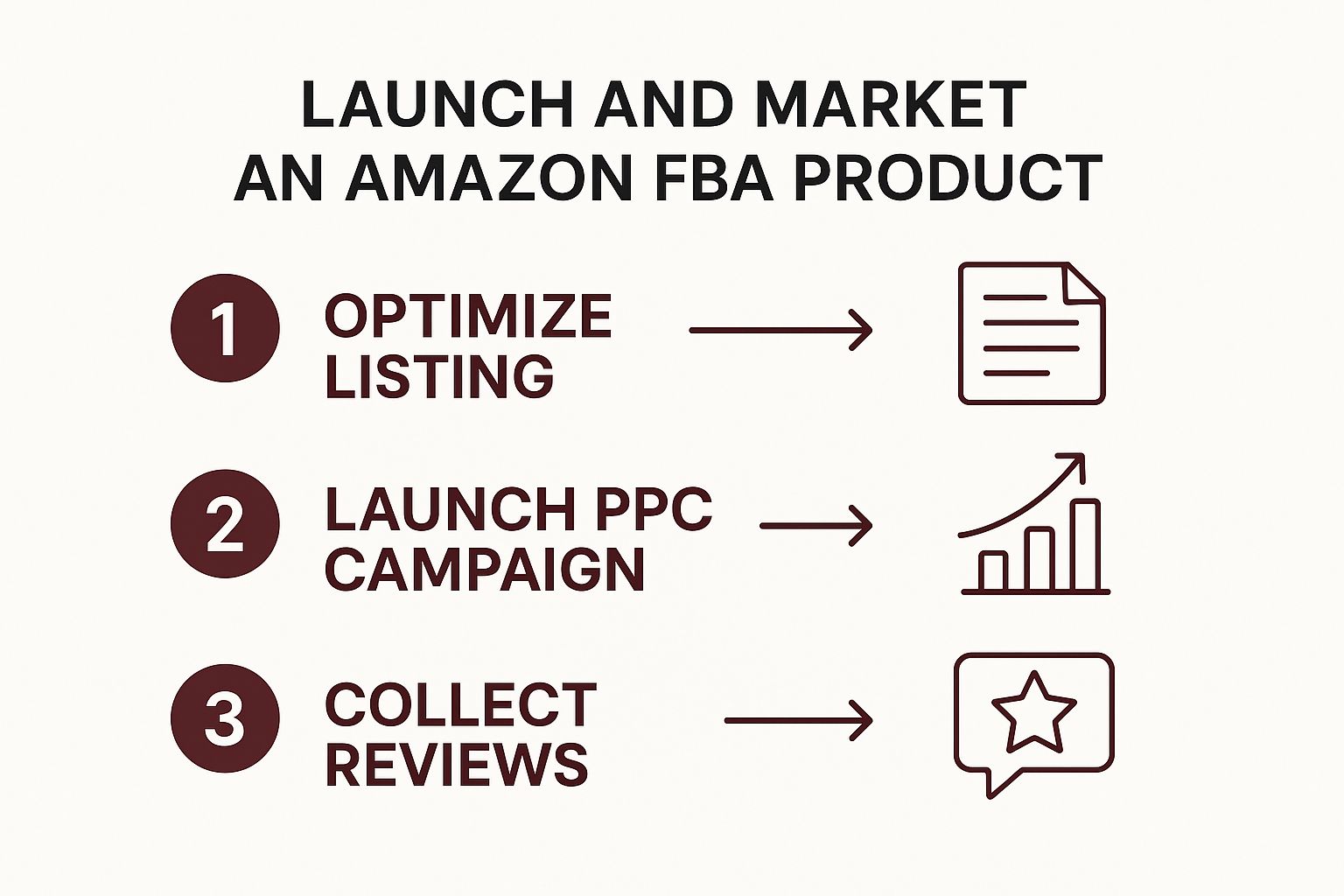
As you can see, a successful launch isn’t a single event; it’s a sequence of connected activities that build on each other.
What’s the Best Way to Pay My Supplier?
For your first order, there’s only one payment method you should even consider: Alibaba Trade Assurance. It works like an escrow service. Your money is held securely until you confirm the order has shipped and, most importantly, meets your quality standards. Whatever you do, never agree to a direct wire transfer (T/T) for 100% of the payment upfront.
The standard, and safest, payment structure is a 30/70 split. You pay a 30% deposit to get production started. The remaining 70% balance is only paid after your products have passed a third-party inspection. This payment structure keeps you in control and makes sure the supplier is motivated to deliver quality goods.
While Amazon’s overall revenue is larger due to its global retail footprint, Alibaba’s growth has been staggering. Between 2017 and 2019, Alibaba’s revenue shot up by 73.5% and 40.7%, while Amazon’s increased by 30.93% and 20.45%. This explosive growth in its home market just goes to show its powerful position in the B2B e-commerce space. You can dig into more insights on this comparison over at MyWifeQuitHerJob.com.
Your Next Step: The path from Alibaba to Amazon FBA is paved with questions, but the answers almost always point back to having a solid process. Vet your partners, protect your payments, and build in safety checks like inspections and prep centers. Taking these deliberate steps is what transforms a potentially risky venture into a calculated, scalable business model.





